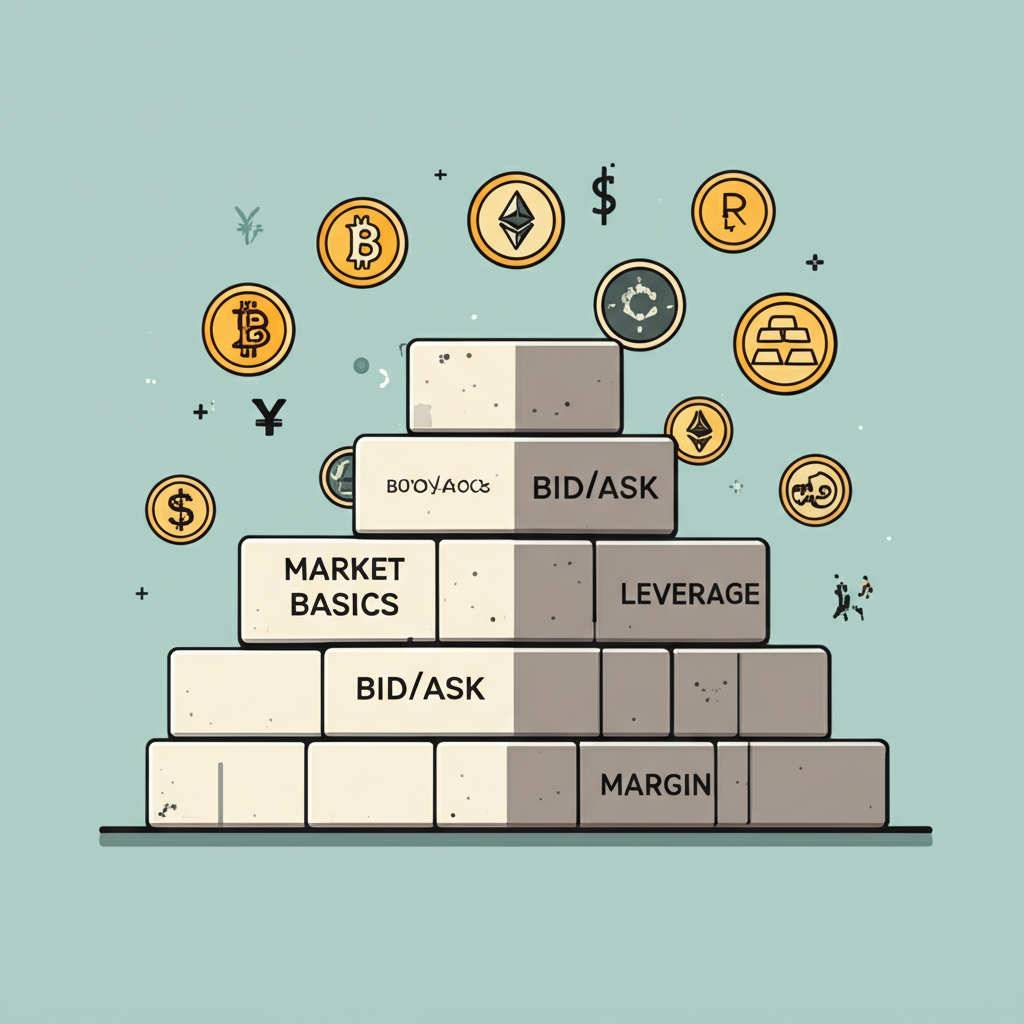Introduction: Navigating the Complex World of Trading
The dream of financial independence through trading draws countless individuals into the dynamic world of financial markets. The promise of autonomy, flexibility, and profit potential is powerful—but so are the challenges that lie beneath the surface. Success in trading isn’t determined by luck or momentary intuition; it’s built on discipline, strategic thinking, and emotional resilience. This guide is designed for both aspiring and intermediate traders seeking to move beyond guesswork and develop a structured approach to trading. We’ll explore the core principles of market mechanics, the psychology behind sound decision-making, and practical strategies that stand the test of time. Whether you’re just starting out or refining your existing approach, these trading tips will help you build a sustainable path forward.

Building Your Foundation: Essential Trading Principles
Just as a skyscraper relies on a solid base, long-term trading success depends on a strong understanding of fundamental concepts. Jumping into live markets without this foundation is like sailing without a map—risky and often disastrous. Establishing a clear framework from the beginning sets the stage for consistent performance and informed decision-making.

Understanding Market Basics and Terminology
Before executing your first trade, it’s essential to speak the language of the markets. Terms like “bid” and “ask” form the backbone of every transaction—the bid represents the highest price a buyer is willing to pay, while the ask is the lowest price a seller will accept. The difference between them, known as the “spread,” acts as a transaction cost and varies depending on market liquidity.
Leverage allows traders to control large positions with relatively small capital, magnifying both gains and losses. The capital required to maintain such a position is called “margin.” Misunderstanding these concepts can lead to unintended exposure and unexpected losses, especially for newcomers.
Markets themselves differ significantly in behavior and accessibility. Stocks reflect ownership in publicly traded companies and are influenced by earnings, management, and industry trends. Forex involves trading currency pairs—such as EUR/USD—driven by macroeconomic factors and central bank policies. Cryptocurrencies, operating on decentralized networks, are known for their high volatility and 24/7 trading cycles. Commodities like gold, oil, and agricultural products are affected by supply chains, geopolitical events, and inflation expectations.
Each market operates under unique conditions—trading hours, volatility profiles, and regulatory environments. A strategy that works in the stock market may fail in crypto due to differing liquidity and price behavior. Recognizing these distinctions is critical to tailoring your approach and avoiding costly missteps.
The Primacy of Risk Management
If there’s one factor that separates successful traders from the rest, it’s risk management. It’s not about avoiding losses—losses are inevitable—but about ensuring they don’t derail your progress. The goal is long-term survival, not short-term heroics.
One of the most effective tools is position sizing. By risking only a small percentage of your account—commonly 1% to 2%—on any single trade, you protect your capital from devastating drawdowns. Even a string of losing trades won’t wipe you out if your position sizes are controlled.
Stop-loss orders are equally crucial. Placing a stop-loss at the time of entry ensures that if the market moves against you, the trade closes automatically, limiting your downside. This removes emotion from the equation and enforces discipline.
Another key principle is the risk-reward ratio. Aiming for trades where potential profits outweigh potential losses—such as 2:1 or 3:1—helps ensure that even with a win rate below 50%, your strategy remains profitable over time.
Ultimately, the aim is capital preservation. As Fidelity Investments emphasizes, protecting your portfolio from major downturns is essential for long-term financial stability, especially in volatile or uncertain markets Fidelity Investments.

Crafting a Robust Trading Plan
A trading plan is more than a set of rules—it’s your personal operating system. Without one, you’re vulnerable to emotional impulses, random entries, and inconsistent results. A well-structured plan includes:
- Clear entry and exit criteria based on technical or fundamental signals
- Defined position sizing and risk per trade
- Preferred markets and timeframes (e.g., daily charts for swing trades)
- Rules for managing open positions, including trailing stops or profit targets
- Guidelines for when to take a break after a losing streak
The real power of a trading plan lies in its ability to remove emotion from decision-making. When a setup meets your criteria, you act. When it doesn’t, you wait. This consistency builds confidence and helps you avoid chasing trades or revenge trading after a loss.
Writing your plan down and reviewing it regularly reinforces commitment. Think of it as a contract with yourself—one that keeps you accountable regardless of market noise or social media hype.
Mastering Your Mind: The Psychology of Trading
Markets don’t move in straight lines, and neither do traders’ emotions. Fear, greed, frustration, and overconfidence can distort judgment and sabotage even the best-laid plans. In fact, psychological discipline often matters more than analytical skill. Many traders know what to do—few consistently do it.
Cultivating Discipline and Patience
Discipline is the ability to follow your plan regardless of short-term outcomes. It means sticking to your risk parameters even when you’re on a winning streak and avoiding impulsive trades during periods of boredom or market frenzy.
Patience, on the other hand, is about waiting for high-probability setups. The market doesn’t owe you a trade every day. Some of the best opportunities arise after extended consolidation or during low-volatility periods when others have given up. The most successful traders aren’t the ones making the most trades—they’re the ones making the right ones.
Think of trading like fishing: you can’t catch fish without bait, but you also can’t catch them if you keep reeling in your line every few minutes. Let your strategy play out, and trust the process.
Conquering Emotions: Fear, Greed, and Impatience
Fear often shows up as hesitation—missing a valid entry because you’re afraid of losing, or closing a winning trade too early out of fear that profits will vanish. Greed, conversely, leads to holding losing positions too long, hoping for a turnaround, or increasing position size after a win to “double down.”
Impatience drives overtrading—taking marginal setups just to stay active. This erodes capital through transaction costs and increases the likelihood of poor decisions.
To combat these emotional traps, many professional traders use tools like journaling, mindfulness practices, and pre-trade checklists. Writing down your mindset before each trade helps identify emotional patterns over time. For example, you might notice that you take more risks after a loss or become overly cautious after a big win.
Another effective technique is the “pre-mortem”: before entering a trade, imagine it has failed. Ask yourself: what went wrong? Was it poor timing, inadequate risk control, or a flawed assumption? This mental exercise prepares you for real-world outcomes and reduces emotional shock when losses occur.
Learning from Losses: Turning Setbacks into Strengths
Losses are not failures—they’re feedback. Every losing trade is an opportunity to refine your process. The key is to analyze objectively, not emotionally.
Conduct a post-trade review for every trade, especially the ones that didn’t work. Ask:
- Did I follow my plan?
- Was the entry based on a valid signal?
- Was my stop-loss too tight or too wide?
- Were external factors—like news events—involved?
Over time, this habit reveals patterns: perhaps you struggle with certain market conditions, or your exits are too early. Armed with this insight, you can adjust your strategy, improve execution, and build resilience.
Remember, even top traders have losing months. What sets them apart is their ability to stay consistent, adapt, and keep trading the plan.
Developing Your Edge: Strategies and Analytical Tools
To generate consistent returns, you need an edge—a repeatable advantage that gives you a statistical probability of success. This edge comes from a combination of analysis, strategy, and execution discipline.
Technical Analysis vs. Fundamental Analysis
Technical analysis is the study of price action and volume to identify patterns and trends. It’s based on the idea that market behavior tends to repeat itself, and all available information is already reflected in the price. Common tools include:
- Moving Averages (MA): Smooth out price data to identify trend direction.
- Relative Strength Index (RSI): Measures momentum and helps spot overbought or oversold conditions.
- MACD (Moving Average Convergence Divergence): Identifies shifts in momentum and potential trend reversals.
Technical analysis works particularly well in short- to medium-term trading, where price patterns and market sentiment drive movement.
Fundamental analysis, by contrast, evaluates an asset’s intrinsic value. For stocks, this means analyzing earnings, revenue, debt levels, and industry position. In forex, it involves studying interest rates, inflation, and economic growth. In commodities, supply-demand dynamics and geopolitical risks are key.
While fundamental analysis is often associated with long-term investing, short-term traders can benefit from understanding major news events—like central bank announcements or employment reports—that cause immediate market reactions.
The most well-rounded traders often combine both approaches: using fundamentals to understand the broader context and technicals to time entries and exits.
Exploring Diverse Trading Strategies (e.g., Day Trading, Swing Trading)
There’s no one-size-fits-all approach to trading. Different strategies suit different personalities, time commitments, and risk tolerances.
Day trading involves opening and closing positions within the same session. It requires focus, fast decision-making, and the ability to manage risk in real time. Because positions aren’t held overnight, traders avoid gap risk but face higher transaction costs and stress.
Swing trading aims to capture price movements over several days or weeks. It’s less time-intensive than day trading and allows for deeper technical and fundamental analysis. However, it requires tolerance for overnight and weekend risk.
Other styles include position trading (long-term holdings based on macro trends) and scalping (ultra-short-term trades lasting seconds or minutes, often using high leverage).
The key is alignment: choose a style that matches your personality, schedule, and emotional capacity. A busy professional may thrive as a swing trader, while someone with full-time availability might prefer day trading.
Backtesting and Forward Testing Your Strategy
No strategy should go live without rigorous testing. Backtesting involves applying your rules to historical data to see how they would have performed. This helps identify flaws, optimize parameters, and estimate win rates and drawdowns.
However, backtesting has limitations. Markets evolve, and past performance doesn’t guarantee future results. That’s why forward testing—or paper trading—is just as important. Using a demo account, you simulate real trading with virtual money, facing actual market conditions, slippage, and emotional pressure.
This dual approach builds confidence and ensures your strategy works in both theory and practice. It also helps you develop the mental habits needed for live trading, such as patience, discipline, and consistent execution.
Practical Application: Actionable Trading Tips for Improvement
Knowledge without action leads nowhere. To turn insight into results, you need to apply what you’ve learned in a structured, measurable way.
Start Small and Scale Up Gradually
Beginners should start with a demo account to practice without financial risk. Use this phase to test strategies, learn platform features, and observe your emotional responses. Once you’ve achieved consistent results in simulation, transition to live trading with a small amount of capital—one you can afford to lose.
This approach lets you experience real market psychology, including the impact of commissions, spreads, and order execution, without endangering your financial stability. As your confidence and track record grow, gradually increase your position sizes and capital allocation.
Scaling too quickly is one of the most common mistakes. Even with early wins, preserving capital should always come before chasing returns.
Continuous Learning and Adaptation
Markets are not static. Economic shifts, technological advances, and regulatory changes all influence trading dynamics. Staying ahead requires ongoing education.
Follow reliable financial news sources like Bloomberg, Reuters, or The Wall Street Journal. Read books by experienced traders—such as Jack Schwager’s *Market Wizards* or Mark Douglas’s *Trading in the Zone*. Attend webinars, take courses, and engage with trading communities to exchange ideas.
Equally important is internal review. Analyze your trades monthly. Are you following your plan? Where are you deviating? Are certain strategies underperforming? Use this data to refine your approach, not abandon it at the first sign of difficulty.
As research from the National Bureau of Economic Research shows, individual investors who commit to learning and adaptation are better equipped to navigate complex financial environments National Bureau of Economic Research.
Choosing the Right Broker and Trading Platform
Your broker is your gateway to the markets. Choose one that’s regulated by a reputable authority—such as the SEC or FCA—to ensure fund safety and fair practices.
Compare fee structures: some charge commissions, others profit from spreads. Watch for hidden costs like overnight financing fees for leveraged positions or data subscription charges.
The trading platform itself should be intuitive, stable, and feature-rich. Look for advanced charting tools, real-time data, customizable indicators, and fast order execution. Mobile access and customer support are also important, especially for active traders.
A reliable broker with a robust platform enhances your efficiency, reduces frustration, and supports long-term success.
Setting Realistic Expectations: Beyond the Hype
The internet is full of stories about traders turning $1,000 into $50,000 in a month or making $1,000 a day with minimal effort. These narratives are misleading and often dangerous. They attract beginners with unrealistic promises and set them up for disappointment—or worse, financial loss.
The truth is that consistent trading success takes time. It requires hundreds of hours of study, practice, and emotional development. Most professional traders aim for modest, sustainable returns—such as 1% to 5% per month—knowing that compounding over time leads to meaningful growth.
Losses are part of the process. Even the best strategies have drawdown periods. The difference lies in risk control and psychological resilience. Successful traders don’t win every trade—they manage their losses and let their winners compound.
Approach trading like a business: create a plan, track performance, manage expenses, and reinvest profits wisely. Focus on long-term capital preservation and gradual improvement, not overnight riches.
Conclusion: Your Journey Towards Becoming a Better Trader
Trading is a journey of continuous growth. It demands patience, self-awareness, and relentless commitment to improvement. While the path isn’t easy, the rewards—both financial and personal—are substantial for those who persevere.
Build your foundation with a deep understanding of market mechanics and risk management. Master your mindset through discipline, emotional control, and consistent self-review. Develop a clear, tested strategy that aligns with your goals and personality. Then, apply it with integrity and adapt as needed.
Remember, sustainable success comes not from a single winning trade, but from thousands of disciplined decisions. Keep learning, stay grounded, and prioritize risk management above all else. With the right trading tips and a long-term perspective, you can evolve into a confident, capable trader—equipped to navigate the markets with clarity and purpose.
Frequently Asked Questions (FAQ)
What are the fundamental differences between day trading and swing trading, and which is better for beginners?
Day trading involves opening and closing all positions within the same trading day, aiming to profit from short-term price movements. It requires intense focus, quick decision-making, and often higher leverage. Swing trading, conversely, involves holding positions for several days to weeks, capturing larger price swings and requiring less screen time. For beginners, swing trading is generally recommended as it allows more time for analysis, reduces the stress of rapid decision-making, and often involves lower transaction costs compared to high-frequency day trading.
How can I effectively manage my risk capital to avoid significant losses in trading?
Effective risk management is paramount. Key strategies include:
- Position Sizing: Limit the amount of capital risked on any single trade, typically 1-2% of your total trading account.
- Stop-Loss Orders: Always place a stop-loss order to automatically close a trade if the price moves against you beyond a predefined point, capping potential losses.
- Diversification: Avoid putting all your capital into one asset; spread your risk across different instruments or markets.
- Risk-Reward Ratio: Ensure that potential profit outweighs potential loss (e.g., aiming for a 2:1 or 3:1 risk-reward ratio).
- Capital Preservation: Prioritize protecting your existing capital over chasing large profits.
What role does technology, such as AI or algorithmic trading, play in modern trading tips?
Technology plays an increasingly significant role. AI and algorithmic trading involve using computer programs to execute trades based on predefined criteria, often at high speeds. These technologies can:
- Analyze vast amounts of data faster than humans.
- Execute trades with precision and without emotional bias.
- Identify patterns and opportunities that might be missed by human traders.
While powerful, they require sophisticated programming and understanding. For most individual traders, their role might be more about using AI-powered analytical tools or understanding how these algorithms influence market behavior rather than directly engaging in advanced algorithmic trading themselves.
Beyond discipline, what advanced psychological techniques can traders use to improve decision-making?
Beyond basic discipline, advanced psychological techniques include:
- Mindfulness and Meditation: To enhance focus, reduce stress, and improve emotional regulation.
- Pre-Mortem Analysis: Before a trade, envision all possible ways it could go wrong and plan contingencies.
- Journaling with Emotional Tracking: Document not just trades, but also your emotional state before, during, and after, identifying triggers and patterns.
- Cognitive Behavioral Therapy (CBT) principles: Challenge and reframe negative thought patterns or biases that lead to poor trading decisions.
- Visualization: Mentally rehearse successful trade executions and disciplined adherence to your plan.
Are there any specific “rules of thumb” like the 3-5-7 rule that every trader should know?
The “3-5-7 rule” is not a universally recognized or standard trading rule. There are various interpretations or niche strategies that might use similar numerical sequences, but generally, it’s not a core principle taught to all traders. More common and important “rules of thumb” include:
- “Cut your losses short and let your winners run”: A fundamental principle of risk management.
- “Never risk more than 1-2% of your capital on a single trade”: For position sizing.
- “The trend is your friend”: Trading with the prevailing market trend often increases success probability.
- “Don’t trade without a plan”: Emphasizes the importance of a well-defined strategy.
- “Know why you’re entering and exiting every trade”: Promotes intentionality over impulse.
How do I identify a reliable source for free trading tips without falling for scams?
Identifying reliable free trading tips requires critical evaluation. Look for sources that:
- Are educational: They teach principles and strategies rather than just providing specific trade signals.
- Emphasize risk management: Legitimate sources always highlight the importance of protecting capital.
- Are transparent: They disclose potential risks and don’t promise unrealistic returns.
- Are reputable: Look for established financial news outlets, academic institutions, or well-known financial educators.
- Provide disclaimers: Reputable sources will clearly state that trading involves risk and past performance is not indicative of future results.
Be wary of any source promising guaranteed profits, rapid riches, or pressuring you into immediate action.
What’s the best way to practice trading strategies without risking real money?
The best way to practice is through a demo account (also known as a paper trading account). Most reputable brokers offer free demo accounts that simulate real market conditions using virtual money. This allows you to:
- Test different strategies.
- Familiarize yourself with the trading platform’s features.
- Understand order types and execution.
- Develop emotional discipline without financial pressure.
It’s a crucial step for beginners before transitioning to live trading with real capital.
How often should I review and adjust my trading plan to adapt to market changes?
Your trading plan should be a living document, not set in stone. It’s advisable to review it at least monthly, or more frequently if significant market events occur or if your trading performance deviates significantly from expectations. Adjustments should be data-driven, based on your post-trade analysis and evolving market conditions, not on impulse. For instance, if volatility increases across the market, you might need to adjust your stop-loss distances or position sizes. Regular review ensures your plan remains relevant and effective.
What are common misconceptions about becoming a profitable trader, and what’s the realistic path?
Common misconceptions include:
- “Get rich quick”: Trading is a skill that takes time, effort, and continuous learning to develop.
- “You need a lot of money to start”: While more capital offers advantages, many successful traders started small.
- “You need to predict the future”: Traders manage probabilities, not certainties.
- “One secret strategy exists”: Success comes from consistent application of a robust plan, risk management, and discipline.
The realistic path involves:
- Thorough education and practice (demo trading).
- Developing a detailed trading plan and strictly adhering to it.
- Mastering risk management and emotional control.
- Starting with small capital and gradually scaling up.
- Continuous learning, adaptation, and objective self-assessment.
How do macro-economic factors influence daily trading decisions, and how can I stay informed?
Macro-economic factors significantly impact asset prices across all markets. Interest rate changes by central banks, inflation reports, GDP growth figures, employment data, and geopolitical events can cause major price swings. For instance, a stronger-than-expected jobs report might strengthen a country’s currency. To stay informed:
- Follow an economic calendar: This lists upcoming data releases and their expected impact.
- Read reputable financial news: Sources like The Wall Street Journal, Bloomberg, or Reuters provide in-depth analysis.
- Understand correlations: Learn how different economic indicators relate to specific asset classes (e.g., oil prices and energy stocks).
- Monitor central bank statements: Their outlooks and policy changes are critical drivers.
Even technical traders should be aware of major news events to avoid unexpected volatility.

留言